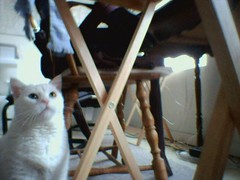Got this from the vet in the mail yesterday. It’s Pandora’s pawprint, impressed into a plaster heart before her necropsy and cremation. We opted not to get the ashes back, so this pawprint suffices for a memorial.
…and Lessons Learned for Future Cat Care
* Watch your cat’s phosphorus intake. While phosphorus is an important mineral for feline health, a lot of off-the-shelf cat foods contain additives with unhealthy levels of phosphorus compounds that disesased kidneys can’t filter efficiently. I fed Pandora Fancy Feast for a while, thinking I was doing her a favor with moist canned food. I didn’t know that Fancy Feast foods are high in phosphorus, which led to the blood toxin peaks that caused her seizure and subsequent decline. Fancy Feast is still good as an occasional treat, but not for daily feeding. With an elderly cat, opt for senior cat foods formulated with low phosphorus and higher moisture, to help maintain long-term kidney health.
* Hyperactivity and sudden weight loss despite increased appetite might indicate hyperthyroidism, which is common in older cats, and should be treated. Otherwise, the enlarged thyroid can cause later complications, including death from organ failure.
* Veterinary compounding is a great way to handle difficult-to-administer cat pills. I found a pharmacy in Vienna, VA that was able to convert Pandora’s huge Azodyl capsules to a tuna-flavored paste. She still found it unpleasant but it was far easier to feed it to her from a fluid syringe than for her to struggle with a giant capsule dropped into her mouth every other day.
* Crib pads: they’re not just for changing babies. When Pandora started having incontinence issues on the couch later in life (due to her kidney condition making her more susceptible to urinary tract infections, and her age-worn muscles making it difficult to stand up to go to the litterbox), these Target crib pads were great for protecting the cushions from urine while keeping the couch presentable when combined with expendable fleece throws. All machine-washable, which helped a lot.
* Finally, emergency vet care can be really expensive, especially if the pet has to stay confined in the facility for a night or two. There is such a thing as pet insurance, and I’ll look into it for the next kitten.




















